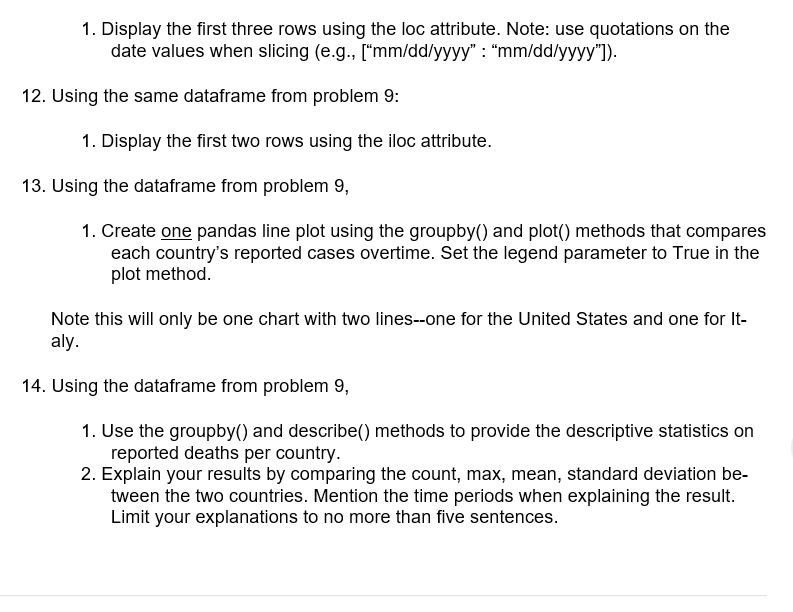Please help 6 - 14 coding questions on Python Jupiter! Please help translate from pseudocode to example code. Step by step each question. Dont worry about the file. I just need the concepts to crush the HW. Thank you!


Code the problems below using Jupyter Notebook. Provide a label for each problem using a comment. Your code solutions must be solved within your notebook in the same order presented below. Make sure to run each cell to display the end result. Save your work as a Jupyter file (.ipynb) and as a PDF file. Upload both files to Blackboard using one submission. The assignment below uses a covid19.csv data file from the European Centre for Disease Prevention and Control. Use the data file provided on Blackboard to complete this assignment. About the Data The data variables in the dataset are: 2. Next, subset that new variable to only include all the data related to the United States, where cases are greater than 0 and store it into a dataframe variable. 3. Then display the last five rows in the subset containing cases greater than 0. (use the tail method) 4. Finally, apply the count method on the date Rep column of the same subset. 6. Apply the same steps as problem 5, but for all the data related to Italy, where cases are greater than 0. 7. In a new dataframe variable: . dateRep = date of reported cases and deaths day, month, year = day, month, and year of each reported case and death cases = the number of reported cases on a given date (dateRep) deaths = the number of reported deaths on a given date (dateRep) countriesAndTerritories = country and territories that report their COVID19 cases and deaths geolD = abbreviation for each countriesAndTerritories popData2019 = population as per country as of 2019 continentExp = associated continent for each location 1. Concatenate both subset dataframes (from problem 5 and 6) using panda's con- catenate function. (use pd.concat(..)) 2. Display the frequencies for each country by using the value_counts() method on the countriesAndTerritories data column from the new dataframe variable in part 7a. 8. Using the dataframe from problem 7: 1. Change the date reported column's data type using the pd.to datetime function. 2. Next, display the data types for each column using the dtypes attribute on the da- taframe. 9. Using the dataframe from problem 8: Note: not all of the variables will be referenced in this assignment. Note: Not all variables above will be used in this assignment. Use one code cell per problem in Jupyter. Problems: The first code cell in Jupyter Notebook will contain the import statement for pandas, followed by the pd.read_csv() function that loads the covid 19.csv file. Include the entire filepath that shows where your file is located on your computer. Assign the data into a variable named your first name (your actual first name). Going forward, there will be additional dataframe variables that will be created and named by you. Each variable name should be descriptive and meaningful, but not too lengthy. Use appropriate name abbreviations. Use your dataframe to complete the following: 1. Display the row index values using the index attribute. 2. Use the set index method to set the date reported variable as the index (also set the inplace parameter to True). Note: 1) The inplace=True will make a permanent change to the dataframe without hav- ing to assign it to a new variable. 2) The rest of the problems will refer to the updated dataframe in this problem. 10. Using the same dataframe from problem 9: 1. Display the shape and column names of the dataframe using their respective attributes. 2. Display the data types for all columns in the dataframe using the respective attribute. 3. Use the head method to display the first three rows in the dataframe. 4. Use the unique method on the countriesAndTerritories column to examine the unique country values. 5. Follow these steps: 1. Use the sort index method and set the inplace parameter to True. 2. Display the first five rows using the head method. 11. Using the same dataframe from problem 9: 1. First, subset your dataframe in a new variable to include all the data related to the United States and apply the copy method. 1. Display the first three rows using the loc attribute. Note: use quotations on the date values when slicing (e.g., ["mm/dd/yyyy" : "mm/dd/yyyy"]). 12. Using the same dataframe from problem 9: 1. Display the first two rows using the iloc attribute. 13. Using the dataframe from problem 9, 1. Create one pandas line plot using the groupby() and plot() methods that compares each country's reported cases overtime. Set the legend parameter to True in the plot method. Note this will only be one chart with two lines--one for the United States and one for It- aly. 14. Using the dataframe from problem 9, 1. Use the groupby() and describe() methods to provide the descriptive statistics on reported deaths per country. 2. Explain your results by comparing the count, max, mean, standard deviation be- tween the two countries. Mention the time periods when explaining the result. Limit your explanations to no more than five sentences








